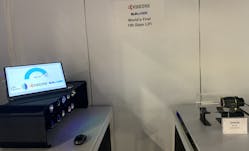Harald Haas, the man known as the father of Li-Fi, is a smart guy who probably mastered his multiplication tables a long time ago. That helps explain how the laser company he’s advising these days recently hit a Li-Fi speed of 100 Gbps, with a terabit in sight.
As LEDs Magazine reported, the 100-Gbps laser-based Li-Fi system that Kyocera SLD Laser (KSLD) demonstrated at the CES consumer electronics show last month was 100 times faster than any LED-based Li-Fi demo, and roughly 700 times faster than typical operational LED Li-Fi.
In brief, Li-Fi uses spectra associated with visible light and infrared (IR) to transmit data. The much more well-known and established Wi-Fi uses radio waves. If nothing else, Li-Fi could open up vast frequency for data services, thus helping to alleviate the crowding and signal interference that can plague Wi-Fi.
Li-Fi augurs other potential advantages as well. One of those is speed. Today’s LED-based Li-Fi is not always a clear winner there compared to Wi-Fi. That’s one reason why gadget makers have largely refrained from embedding Li-Fi into laptops, tablets, and phones. That in turn has meant slow Li-Fi adoption among end users, who have to attach dongles to receive and send Li-Fi signals.
But lasers are much faster than LEDs, owing to their stimulated emission technology, as opposed to LEDs’ slower spontaneous emission. KSLD’s 100 Gbps is a stellar example. Not only is it much faster than LED Li-Fi, but it also provides the white light of illumination. Increasingly, LED Li-Fi installations are working via IR and not always providing the concurrent function of illumination, such as at a recent Long Island school installation.
So how did KLSD do it?
The short answer: By combining 10 laser diodes, each delivering data at 10 Gbps via a different wavelength than the other. It doesn’t take a really smart guy like Haas to figure out that 10 × 10 = 100. It’s the basic math that underpins the KSLD approach.
Obviously there’s a lot more to it than that.
Speeding toward commercialization?
Let’s get back to Haas, who wears many Li-Fi industry and academia hats these days, including serving as senior advisor to KSLD on laser Li-Fi developments. LEDs had a chance to speak to him and to KSLD senior vice president of business development Paul Rudy about the 100-Gbps demo.
They explained that KSLD transmitted with 10 different surface-emitting laser chips, each at a different frequency. Three of them emitted in the blue spectra, at 430, 440, and 450 nm. The other seven emitted in the IR range, starting at 800 nm and ranging up to 1100 nm. All 10 were modulated to encode data. Optical fiber from each ran into a transmitter (on the right in the photo), which wirelessly sent all the signals across to a unit divided into 10 different receivers, each of which was tuned into one of the 10 frequencies.
Why bother to use 10 different frequencies? Why not deploy 10 of the same-frequency chip and thus seemingly make things simpler? There are two related answers: A set of 10 same-frequency chips would clash signals with each other. By using 10 nonclashing wavelengths, KSLD can divide datasets in a practical manner for end users. For example, Li-Fi on a plane could send data to one passenger at, say, 450 nm and to another at 900 nm.
“With spatial multiplexing, we can deliver different data to different locations if we want,” explained Rudy. “You can imagine in an aircraft cabin, you’d have different passengers’ seats getting different data.”
The airplane example is an apt one, as last August Santa Barbara, CA-based KSLD began providing Seattle-based avionics data networking company Spectrum Networks with Li-Fi components that Spectrum will use to build laser Li-Fi into airplanes at around 1 to 2 Gbps, which is currently KSLD’s fastest commercialized version.
Rudy believes that it will take about two to four years to miniaturize the components in the 100-Gbps system into a commercialized form, and to get it to perform at distances greater than the meter-and-a-half length at CES in Las Vegas.
And things could well speed up from there, notes Haas, applying some simple math.
“We may not stop at 10,” he said, referring to the number of lasers in a transmitter. “We may add 100. And then you can scale the data rate. So there’s a path to a terabit, for example, if you just add more wavelength, miniaturize, and make it smaller. It is really showing this beautiful capability of light communication, of futureproofing future wireless communication. We have a big piano. Every wavelength is a key. You just have to play every key, and that makes a beautiful piece of music.”
Leading the way toward lasers
If anyone knows about the orchestration of light-based wireless communication, it’s Haas. He is credited with inventing the technology before pioneering its commercialization by co-founding pureLiFi (then called pureVLC) in Edinburgh, Scotland in January 2012, where he is still chief scientific officer. He is a leading academic figure in its development, having served as a professor in the field for many years at the University of Edinburgh before departing in July 2020 to become distinguished professor of mobile communications at the University of Strathclyde in Glasgow, where he is also the director of the LiFi Research and Development Centre.
In the UK, Haas also contributes to a government-funded group called Terabit Bidirectional Multi User Optical Wireless System for 6G (TOWS), which is working toward hitting terabit-per-second speed by 2024.
Data transmission is only part of the engineering advances underway at KSLD that could help finally usher in Li-Fi as a mainstay wireless communication option. They are also manipulating lasers so the light is not dangerous to look at and will be able to serve general illumination purposes. For example, the passenger plane Li-Fi will use lasers as reading lights as well as data sources.
Rudy and Haas had plenty to say about how they are working on that, and on the many applications where laser Li-Fi could take hold. Haas even sees integration into solar panels. LEDs Magazine will bring you more.
MARK HALPER is a contributing editor for LEDs Magazine, and an energy, technology, and business journalist ([email protected]).
For up-to-the-minute LED and SSL updates, why not follow us on Twitter? You’ll find curated content and commentary, as well as information on industry events, webcasts, and surveys on our LinkedIn Company Page and our Facebook page.






